by tmoffett | Jan 7, 2014 | Color, Landscape, Photographic Philosophy, Photographic Technique
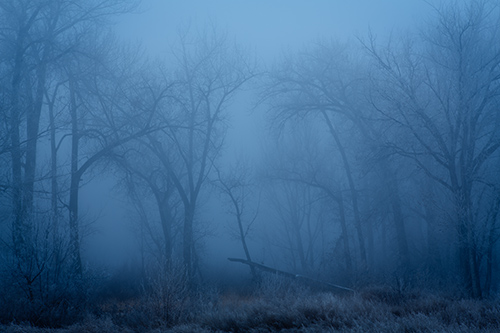
Into The Unknown
Photography has been a major part of my life for many years. I started shooting snapshots with a toy camera when only seven or eight years old. I graduated to a Kodak Instamatic 110 when I was about ten. I remember fighting back tears when I was told that the Community Education photography class I had registered for shortly after receiving the Kodak camera had been canceled. I was only ten and knew nothing more than how to take snapshots, but I realized that there was more to be discovered. I settled for what that little camera could deliver until high school, when I purchased my first SLR, a Pentax ME Super. I promptly registered for a photography class and was hooked.
Over the years, through both formal education and experience, I have learned that photography can be a meaningful art form. Powerful messages can be delivered and personal feelings can be shared. However, just because photography can do these things, doesn’t mean it always does. Techniques must first be practiced and mastered and personal vision developed so that thoughts and feelings can be successfully rendered in the final image. I constantly stress to my students that technique must be mastered to the point that they no longer have to think about it, it just happens. Then, and only then will they be able to really let their feelings flow into their images.
One cold morning last week I was out by the lake in the dense fog. I was all alone, walking a path I had been on many times before, but this time it was different. At -8°C and all alone in a sea of fog, an eeriness that is hard to describe enveloped me. As I strained to see through the fog, a scene that many times would have appear to me in lighter tones and more neutral in color, appeared instead in darker tones and cold shades of blue. I could barely make out a few warmer shades of color in the brush in the foreground. My feelings were changing the way I viewed the world. The process of photographing the scene before me now became just a formality. The vision of the finished image was already there! Thought, feeling, technique and vision all worked in unison to create a photograph that described how I was feeling better than any words, or at least my words, could.
by tmoffett | Sep 3, 2012 | Color, Landscape, Photographic Technique
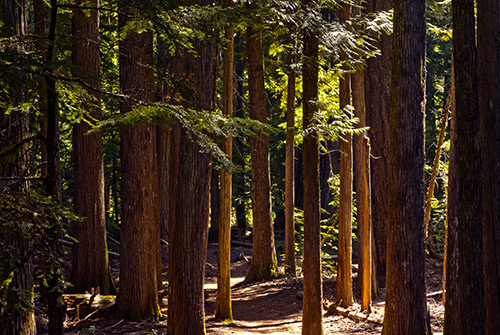
Trail to Proxy Falls
Another trip to photograph on the Oregon Coast is on the horizon, and I am sitting at my computer reviewing some of the images from my trip last month. The image above was actually taken on my way home. We drove the McKenzie Highway for the first time last month, as it has always been closed on my other return trips. It is a very interesting drive, and if taken early morning or late evening I can imagine some spectacular photographs could be made. Photography is all about the light, and in the middle of the day in most places, the light is not ideal.
One stop that we made in the morning was at Proxy Falls. We arrived at the lower falls just before the sun made its way over the ridge, giving us great light for about thirty minutes. I did make some great images, which will be posted another day, but what I want to discuss today is the image above. As Christeena and I made our way from the lower falls to the upper falls, we hiked through this small area of thick trees, and the light seemed to be bouncing around and reflecting off trees and rocks in such a way as to create this nice golden color, something that I don’t see very often. Just a few minutes later and the angle of the light would be too high to create this look. It would become harsh and unattractive. Learning to recognize the subtle changes in light quality is a must for a successful photographer. Once able to recognize, we must then master our equipment so as to be able to capture the quality of light in our photographs. Often I will be set up beside other photographers who I notice have cameras set on auto and then bracket their exposures like crazy, hoping to get the image that they see in their minds eye. I, on the other hand, take my time, feeling the scene, setting the camera and making just a few exposures, knowing that I have what I need.
Light is what we work with. Light strikes a subject and bounces back to my lens and is focused on the camera sensor. Understanding the properties and physics of light cannot be over-emphasized. Without that knowledge, I never would have recognized what was happening on the hike to Proxy Falls, let alone know how to capture it. Due to the high contrast in the scene, this was a very difficult photograph to make. Sure, I could have just settled for what the camera thought would be good, but then the shadows would have been so dark that the nice detail in them would be lost. Rendered any brighter and the highlights would be so overpowering that the rich golden glow would become lost. Only a perfect exposure would capture what I needed in the file to make the perfect print. And perfect is what I got!
by tmoffett | Aug 21, 2012 | Color, Landscape, Photographic Philosophy, Photographic Technique, Uncategorized
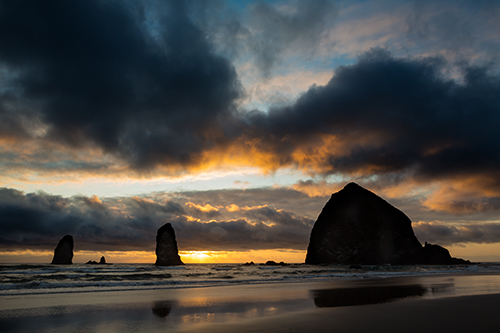
Haystack Rock and The Needles
Recently I was on the Oregon Coast, hoping to photograph some great skies over the ocean. On most of my trips to the coast I have encountered a great deal of fog, which is interesting, but I was looking for something different. Several evenings looked very promising, and then at the last minute fizzled out. On this particular evening, we had a wonderful sunset, for about 2 minutes, and then the sun dropped below the marine layer and all of the color disappeared. I worked hard and fast to position myself to capture this scene, and it made the entire trip worthwhile!
As is so often the case, the light changed so rapidly that I was very thankful to understand the technical side of photography. If I had been relying on the camera to make all of my decisions, I highly doubt that I would have been successful here. With such a high contrast scene, maintaining detail in both shadows and highlights and keeping good saturation in the color is not an easy task. Some would say to shoot several exposures and layer them, or shoot for HDR. Why, when it can be done, in my opinion, better in a single image? I have been and always will be a fan of getting it right in camera. It makes the printing process so much simpler and usually cleaner and sharper.
To really understand photography to the point of creating what my minds eye sees, and doing so almost without thinking has taken a lot of study, practice, mistakes, evaluation, more mistakes, and on and on. All of that time and effort has paid off for me many times over. One of the hardest things to convince my students of is that it is OK to make mistakes. That is how we learn. I still, after 30 plus years of practice, make mistakes. The difference, though, is that I evaluate them and learn from them. They make be better!
by tmoffett | Aug 14, 2012 | Color, Landscape, Photographic Philosophy, Ramblings
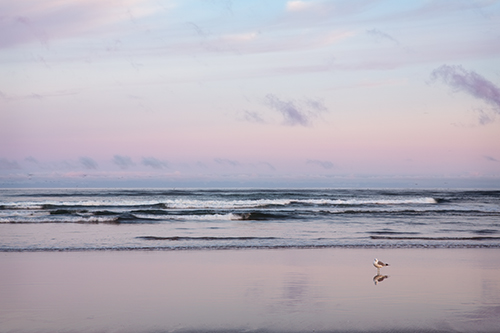
Lone Gull, Seaside,Oregon
Everyone thinks that the life of a photographer is a dream job. I do love my life and think this is a great job, but I must say it is more difficult (but rewarding!) than most think it to be. I just returned from a photography trip to the Oregon Coast, and I feel like I need a week to recover. While I did get to spend a lot of time doing what I love and visiting some of the greatest places on this planet, the schedule was brutal. It was so exhausting that I didn’t even get on the computer to blog, and I love blogging!
A normal day started at 4:30 or 5:00 in the morning. I would get up, get dressed and head out to a predetermined location. I would arrive enough before sunrise to allow me to get a feel for the area and determine what I needed to photograph. Due to the marine layer (fog) that I had all week, I was able to photograph for about two hours before the light became too harsh for my taste. I would then go back to the hotel and clean up for the day and get breakfast. Hiking and exploring were the days activities, often finding new places for the morning and evening photography sessions. After an early dinner, I would head back out with cameras for the evening light. The evening session would keep me going from about 7:00-10:00. I love photographing until it is too dark to focus, as I find some of the most interesting light is after sunset. I then go back to the hotel, download the days images, clean and prep my gear for the morning, and get to bed about midnight or later. After a week of four hours per night of sleep and rigorous schedules during the day I am ready for a break!
Even though I keep a crazy schedule, I love what I do. I have learned to see the world in a different light, one that I love sharing. Even when I don’t have a camera in hand, I see things in my own way. I have learned, as Dewitt Jones puts it, to “Celebrate what’s right in the world.” I look for the extraordinary, and have found that when you look with an open mind, you will find it. That is what makes it worth it.
by tmoffett | Jul 30, 2012 | Color, Composition, Landscape, Photographic Technique
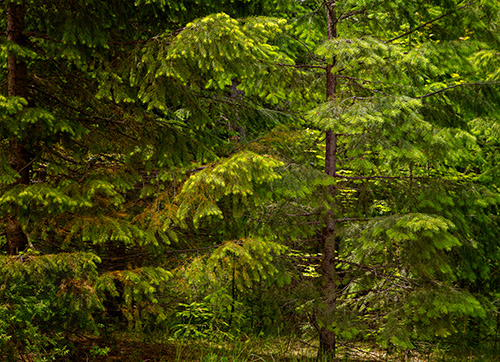
Trees
Just about anything can become interesting subject matter for a photographer. I was looking through images that I made on a family trip a while back, and came upon this one. I recall stopping to look at the river that was running swiftly over some rocks, but after stopping the car this tree caught my attention. The sun had gone behind some high clouds, softening the light, which is always a good thing. The leaves on a tree behind the pine tree here seemed to wrap around the trunk. I sat trying to figure out what it was that made the scene work and how to capture what I was feeling. I knew that the sun would soon return, so I made some quick decisions and this is what I came up with. I really like the new growth showing on the tips of the branches. The monochromatic color scheme always works for me as well. It is just a simple tree, but I like it. To me, simple is beautiful.







Recent Comments